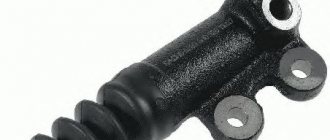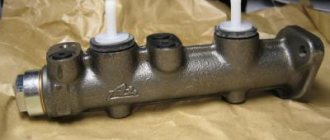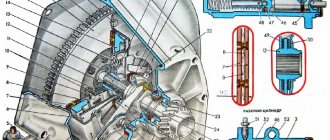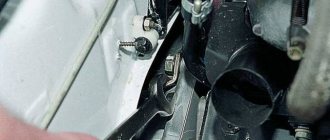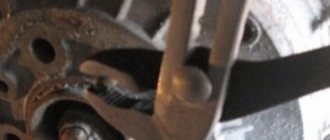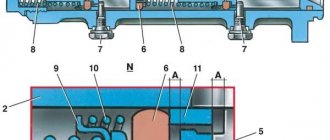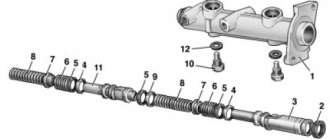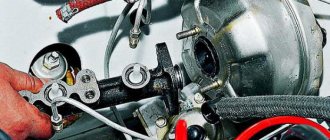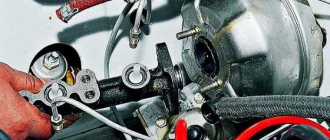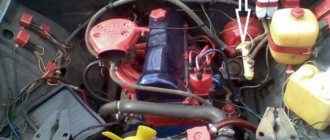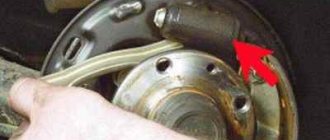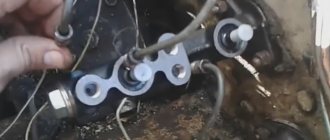One of the main parts of the hydraulic drive of the clutch system, along with the main one, is the clutch slave cylinder. The main task of this device is to transfer the force generated when the pedal is pressed and coming from the master cylinder through a hose to parts that directly interact with the gearbox: the clutch fork and the release bearing.
Traditionally, the clutch slave cylinder is located on or next to the gearbox housing and is similar in its principle of operation and design in all car models, only the details differ: what the body, rod, etc. are made of.
To independently repair or replace this part, you need to understand the principle of its operation, the main components located in its body and the signs of possible malfunctions.
Operating principle of the clutch slave cylinder
The hydraulic clutch slave cylinder receives the force imparted by the pedal to the master cylinder and, as a result of the pressure created in the pipeline, transmits it directly to the fork, which acts on the release bearing. It is an integral part of the system and is a cylindrical product attached to the clutch basket housing. A hydraulic drive tube enters it, and a rod comes out, resting on the cylinder piston on one side, and on the clutch fork on the other.
Operating principle and design
By pressing the pedal, there is an impact on the main cylinder, where pressure is created, as a result of which hydraulic fluid enters the working cylinder through the hose and discharge valve and, through the rod, actuates the pusher, which, by squeezing the fork, helps to engage or disengage the selected gear.
The design of the working cylinder shown in the photo is not as complicated as it might seem at first glance. It consists of the following main parts:
- respectively, the body itself, which can be plastic or iron;
- an air release valve located on it, which is used when pumping;
- return spring;
- working rod (piston);
- a pusher acting on the fork;
- retaining ring;
- rubber parts: o-rings and cuffs.
Clutch cylinder parts: 1 – housing;
2 – fitting; 3 – cap; 4 – pusher; 5 – sealing ring; 6 – piston; 7 – sealing ring; 8 – plate; 9 – spring; 10 – washer; 11 – retaining ring Wear or malfunction of some of the above parts can lead to deterioration of the entire clutch system, which can be judged by certain signs.
How to choose a clutch slave cylinder
When replacing the clutch slave cylinder, it is advisable to buy an original product made by the car manufacturer. If this is not possible, it is possible to install similar spare parts from a third-party manufacturer, but there is a high risk of purchasing a low-quality product. A part that has a price significantly lower than the original will quickly fail due to low-quality components and poor workmanship. This makes a cheap purchase economically unprofitable, since the need to purchase a quality product will remain.
Reasons for replacing and adjusting the VAZ 2107 clutch
Replacing a VAZ 2107 clutch is a rather labor-intensive and expensive process. Therefore, before replacing, you should consider adjusting the mechanism.
Clutch replacement
To install a new clutch, you will need an inspection hole, overpass or lift. It is important to detect in time the signs indicating the need to replace the clutch (it is impossible to replace it on the road), and take the car to a garage or car service center. Driving with a faulty clutch is very dangerous - you can get into an accident when crossing a railway crossing or a main road.
The entire VAZ 2107 clutch is replaced, so auto shops sell a kit consisting of a driven disc, a basket and a release bearing. You should consider replacing the clutch in the following cases:
- the car climbs heavily uphill when the accelerator pedal is pressed all the way down, and you can smell a burning smell - these are signs of slipping of the driven part of the clutch;
- when the clutch is disengaged, noises appear in the area of the flywheel housing - this indicates a malfunction of the release bearing;
- when starting the car, it is difficult to engage first gear (the gearbox “growls”) - this is a sign that the clutch is not completely disengaged (the clutch is moving);
- when accelerating, the car begins to twitch, rattling sounds are heard - the reason for this is usually broken damper springs or loose sockets for them on the driven disk, deformation of segments or loose rivets on the hub.
Any noise, vibration, or whistle in the clutch area requires more detailed diagnostics and diagnosis.
Clutch adjustment
If the clutch pedal becomes too soft, falls down, and does not return to its original position, then most likely air has entered the system or the hydraulic drive adjustments have been disrupted. Clutch slipping after prolonged use usually indicates a failure of the clutch. It will probably have to be changed.
If the clutch drives, that is, shifts gears with difficulty, in about half of the cases the reason is a discrepancy with the required values:
- play between the rod and the piston in the working cylinder;
- clearance between the release bearing and the fifth basket;
- free and working travel of the foot pedal.
Installation or replacement
Removing or replacing the clutch slave cylinder is carried out in the following order:
- Unscrewing the pair of bolts securing the cylinder body to the clutch housing.
- Disconnecting the pusher from the clutch fork.
- Disconnecting the hose connecting the clutch slave and master cylinders.
- Plug the hose with a suitable size plug to prevent liquid leakage.
Installing a new or repaired wheel cylinder is carried out in the reverse order, after which the system is pumped to fill it with brake fluid and remove air. During assembly, a special lubricant is applied to the pusher axis, usually CASMOLY L9508.
How to adjust the clutch rod on a VAZ 2106
After bleeding the working cylinder, it is necessary to adjust the clutch rod. To do this you will need:
- set of open-end wrenches;
- medium-sized caliper;
- pliers.
Adjustment sequence
Before you begin making adjustments, you should look at the machine's operating instructions . It is there that you can clarify all the necessary tolerances for the clutch rod and pedal.
- First, the clutch pedal play (also known as free play) is measured. The most convenient way to measure it is with a caliper. Normally it is 1–2 mm.
- If the free play exceeds two millimeters, then use a 10 mm open-end wrench to unscrew the nut located on the free play limiter. After this, you can turn the limiter itself and set the required free play of the pedal.
The free play of the clutch pedal is adjusted using the limit pin - Once the stop pin is installed properly, its nut is screwed into place.
- Now you need to measure the full amplitude of the pedal. It should be in the range from 24 to 34 mm. If the amplitude does not fall within these limits, the rod should be readjusted and then the measurements repeated.
Video: how to adjust the clutch drive
Clutch slave cylinder malfunctions
The following signs indicate an impending repair or replacement of the clutch slave cylinder:
- A sharp decrease in the fluid level in the reservoir with characteristic spots under the car in the area where the working brake cylinder is located. Signs indicate a fluid leak due to wear on the cuffs or damage to the integrity of the hose. Eliminated by replacing worn parts and restoring the tightness of the system.
- Dips or too soft clutch pedal travel. They indicate that air has entered the system, which is eliminated by bleeding. When examining the cylinder and finding cracks or leaks on the body through which air passes, the product is partially repaired or replaced.
- Gradual sagging of the clutch pedal and problems with gear shifting, while the fluid level in the reservoir does not drop, and adjusting the pedal does not bring any results. These are signs of a broken working cylinder spring; the problem can be eliminated by replacing it.
Device location
To find the clutch slave cylinder on a VAZ classic, you need to look for it directly in the area where the gearbox is located. The device is attached with two bolts to the gearbox housing.
The mechanism can only be seen from below or in the very depths of the engine compartment on the driver’s side. Repair work related to dismantling and replacing the clutch slave cylinder can be carried out “from under the hood,” but it is much more convenient from an inspection hole or on an overpass. The video below shows the location of this unit. What function does this product perform and is it possible to do without it? We'll find out more about this later.
Features of operation
The operating principle is very simple. Below is a diagram where the slave cylinder is indicated by a green arrow.
According to this diagram, we can say that the RCS performs an important function, or rather, it activates the fork, which is connected to the clutch drum. The main element of the RCS, or rather the piston, is activated by the resulting fluid pressure coming from the main cylinder through the hose when the clutch pedal is pressed. The brake fluid pushes the piston, which in turn drives the fork, which acts on the drum, pushing the disc away from the flywheel. Many people wonder why brake fluid is used in the system? The reason is that brake fluid is incompressible, which is why it is used in such important systems as brakes and clutches.
When to replace the RCS
During the use of the unit, which happens very often, the product tends to fail. The main causes of breakdowns are chafing and wear of the cuffs, the appearance of cracks in them, which entails the leakage of liquid. Significant loss of fluid will cause the clutch system to malfunction. It is possible to repair a DCS that has become unusable, but it is easier and more efficient to replace it with a new one.
In order not to wait until the pressure in the clutch pedal disappears, you need to periodically inspect the unit. If there is a leak in the fuel fluid, it is necessary to immediately carry out the appropriate repairs on the VAZ 2107. Before carrying out repairs, you need to make sure that this particular element is faulty, since the main circulation system may also fail. The main signs of failure of the RCS are:
- decrease in the level of fuel fluid in the tank;
- visible brake fluid leaks from the device body or from under the rubber boot;
- “failures” of the clutch pedal, which can be periodic or constant;
- difficulty changing gears.
But most often the malfunction is determined by detecting a brake fluid leak.
Features of replacing the RCS
Replacing the VAZ 2107 clutch slave cylinder begins with the need to remove all fluid from the reservoir. Further actions are carried out in order:
- First you need to loosen the fastening nut that connects the hose to the cylinder. There is no need to unscrew the nut completely, just loosen it at this stage.
- Using pliers, you need to remove the tension spring.
- After this, you should unclench the cotter pin and remove it from the tip of the pusher.
- Using a key set to “12”, you need to unscrew the two bolts that secure the product to the gearbox housing.
- After unscrewing the bolts, you can disconnect the bracket from the cylinder, which is intended to secure the spring.
- Holding the working cylinder body, you should dismantle it. During dismantling, pay attention to the pusher, which is located in the fork.
- After disconnecting the product from the crankcase, you can continue unscrewing the nut connecting the hose to the device. After unscrewing the nut, brake fluid will begin to flow out of the hose, so you should prepare a special container in advance.
After the device is dismantled, it should be replaced with a new one, since repairing it is irrational. The cost of the product is insignificant, so it is easier to replace it with a new one than to try to carry out repairs. Installation of the product is carried out in the reverse order of removal. After installation, it is necessary to carry out the system bleeding procedure. In conclusion, it should be recalled that regular car maintenance helps prevent various unforeseen consequences along the way, such as the “disappearance” of the clutch.
This is interesting: Why did the oil pressure indicator light come on in a VAZ 2114/15 car: we are looking for reasons and solutions
Repairing the clutch slave cylinder using a repair kit
Repairing the clutch slave cylinder begins with disassembling it. To do this, it is placed in a vice for convenience, after which the work is carried out in the following order:
- Removing the protective cap with the pusher, removing the piston and removing the retaining ring from it.
- Removing the sealing rings and spring from the piston.
- Cleaning all holes in the cylinder and the air outlet fitting.
- Inspection of the cylinder mirrors and the outer surface of the piston for mechanical damage.
- Flushing all parts and surfaces with brake fluid. The use of other solvents for this purpose is prohibited.
- Installation of parts of the repair kit, which includes a spring, a protective cap and piston o-rings.
- Cylinder assembly.
Some tips for repairing the master cylinder
Tip #1 . There is no need to completely drain the brake fluid from the hydraulic clutch when replacing the master cylinder (this is not at all necessary).
Tip #2 . To flush spare parts of the clutch master cylinder, it is not advisable to use the following products:
- kerosene;
- diesel fuel;
- petrol;
- mineral oils.
To avoid damage to clutch cylinder components, use only brake fluid.
Tip #3 . Before final assembly of the repaired GTZ, its spare parts must be lubricated.
Tip #4 . To process the piston, which interacts with the pusher, a special grease is used.
Tip #5 . After installing the master cylinder, it is imperative to bleed the hydraulic drive system.
Bleeding the clutch slave cylinder
After installing the working cylinder in place, it is pumped as follows:
- Fill the master cylinder reservoir with brake fluid.
- A tube with the other end lowered into a container with brake fluid is connected to the air bleeder fitting of the working cylinder, which has been previously unscrewed ¾ of a turn.
- Repeatedly press the clutch pedal until air bubbles stop appearing from the tube, after which, with the pedal pressed all the way down, the fitting is screwed in.
- Disconnect the hoses and check the fluid level in the tank, which is topped up if necessary.
The described actions make it possible to eliminate the malfunction of the working cylinder of the clutch of all models of the VAZ: 2101, 2102, 2103, 2104, 2105, 2106, 2107, 2108, 2109, 21099, 2110, 2111, 2112, 2113, 2114, Niva, Priora, Starine, Grant, Grant. Vesta and most foreign cars.
Clutch drive and its types
The drive is designed for remote control of the clutch directly by the driver from the passenger compartment. Pressing the clutch pedal directly affects the pressure plate.
The following types of drive are known:
- mechanical;
- hydraulic;
- electrohydraulic;
- pneumohydraulic.
The first two types are most widespread. Trucks and buses use a pneumatic-hydraulic drive. Electrohydraulic is installed in cars with a robotic gearbox.
Some cars use a pneumatic or vacuum drive booster to make driving easier.
Mechanical drive
A mechanical or cable drive has a simple design and low price. It is unpretentious in maintenance and consists of a minimum number of elements. The mechanical drive is installed in passenger cars and light trucks.
Mechanical clutch drive
Mechanical drive elements include:
- clutch cable;
- clutch pedal;
- clutch release fork;
- release bearing;
- adjustment mechanism.
The clutch cable, enclosed in a sheath, is the main element of the drive. The clutch cable is attached to the fork, as well as to the pedal located inside the car. When the driver presses the pedal, the action is transmitted through the cable to the fork and release bearing. As a result, the engine flywheel is disconnected from the transmission and, accordingly, the clutch is disengaged.
The connection between the cable and the lever drive has an adjustment mechanism that ensures free movement of the clutch pedal.
The clutch pedal travel is free movement until the drive is activated. The distance covered by the pedal without much effort from the driver when pressed is free play.
If gear shifting is accompanied by noise, and at the beginning of the movement there are slight jerks of the car, then adjustment of the pedal travel is necessary.
The clearance in the clutch should be within 35-50 mm of pedal free play. The standards for these indicators are indicated in the technical documentation of the car. Adjustment of the pedal stroke is carried out by changing the length of the rod using an adjusting nut.
Trucks use a lever mechanical drive rather than a cable drive.
The advantages of a mechanical drive include:
- simplicity of the device;
- low cost;
- reliability in operation.
The main disadvantage is considered to be lower efficiency compared to a hydraulic drive.
Hydraulic clutch drive
The hydraulic drive has a more complex design. Its elements, in addition to the release bearing, fork and pedal, also include a hydraulic line, which replaces the clutch cable.
Hydraulic clutch diagram
In essence, this line is similar to the hydraulic drive of the brake system and consists of the following elements:
- clutch master cylinder;
- clutch slave cylinder;
- reservoir and pipeline with brake fluid.
The clutch master cylinder is similar to the brake master cylinder. The clutch master cylinder consists of a piston and a pusher located alone in the housing. Its elements also include a fluid reservoir and sealing collars.
The clutch slave cylinder, which has a similar design to the master cylinder, is additionally equipped with a valve to remove air from the system.
The mechanism of action of a hydraulic drive is the same as that of a mechanical one, only the force is transmitted using the liquid in the pipeline, and not through a cable.
When the driver presses the pedal, the force is transmitted through the rod to the clutch master cylinder. Then, due to the incompressible properties of the fluid, the clutch slave cylinder and the release bearing drive lever are activated.
The advantages of the hydraulic drive include the following features:
- hydraulic clutch allows you to transmit force over a considerable distance with high efficiency;
- resistance to fluid flow in the hydraulic drive elements contributes to smooth engagement of the clutch.
The main disadvantage of a hydraulic drive is that it is more difficult to repair compared to a mechanical one. Leakage of working fluid and entry of air into the hydraulic drive system are, perhaps, the most common breakdowns that the clutch master and slave cylinders can boast of.
The hydraulic drive is used in passenger cars, as well as on trucks with a tilting cab.
Popular models and manufacturers
When choosing a non-original clutch slave cylinder, products from the following manufacturers are most often used:
- Sachs. The German company is a leading manufacturer of clutch cylinders for most automobile brands of foreign and domestic manufacturers. The popularity is due to the high quality of products and the use of innovative developments.
- Lukas. The largest manufacturer of auto parts, whose products meet all international quality standards. It produces brake cylinders for most automobile brands and repair kits for them.
- Fenox. Specializing in the production of clutch and brake cylinders for more than 25 years. Supplies products to most automakers.
- TRW. The company owns the Lukas brand and supplies brake system components, in particular brake cylinders, for all the world's largest automakers. The products are distinguished by their quality and extreme reliability.
- LUK. Official partner of major automakers in terms of designing new developments and systems. Supplies clutch cylinders to assembly lines of most of the world's major automakers.
